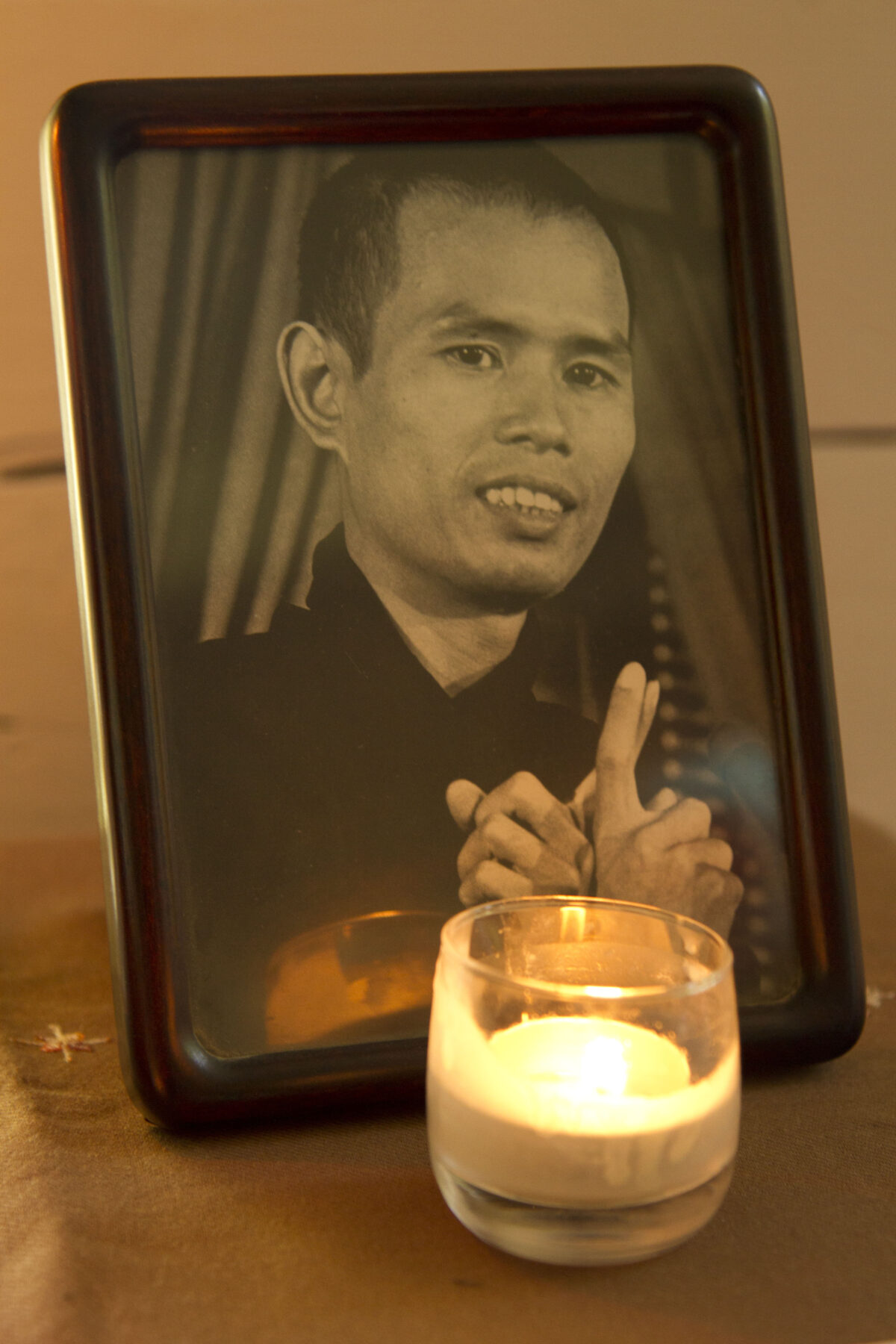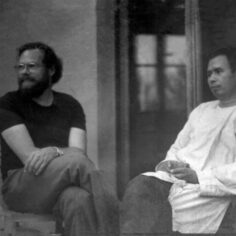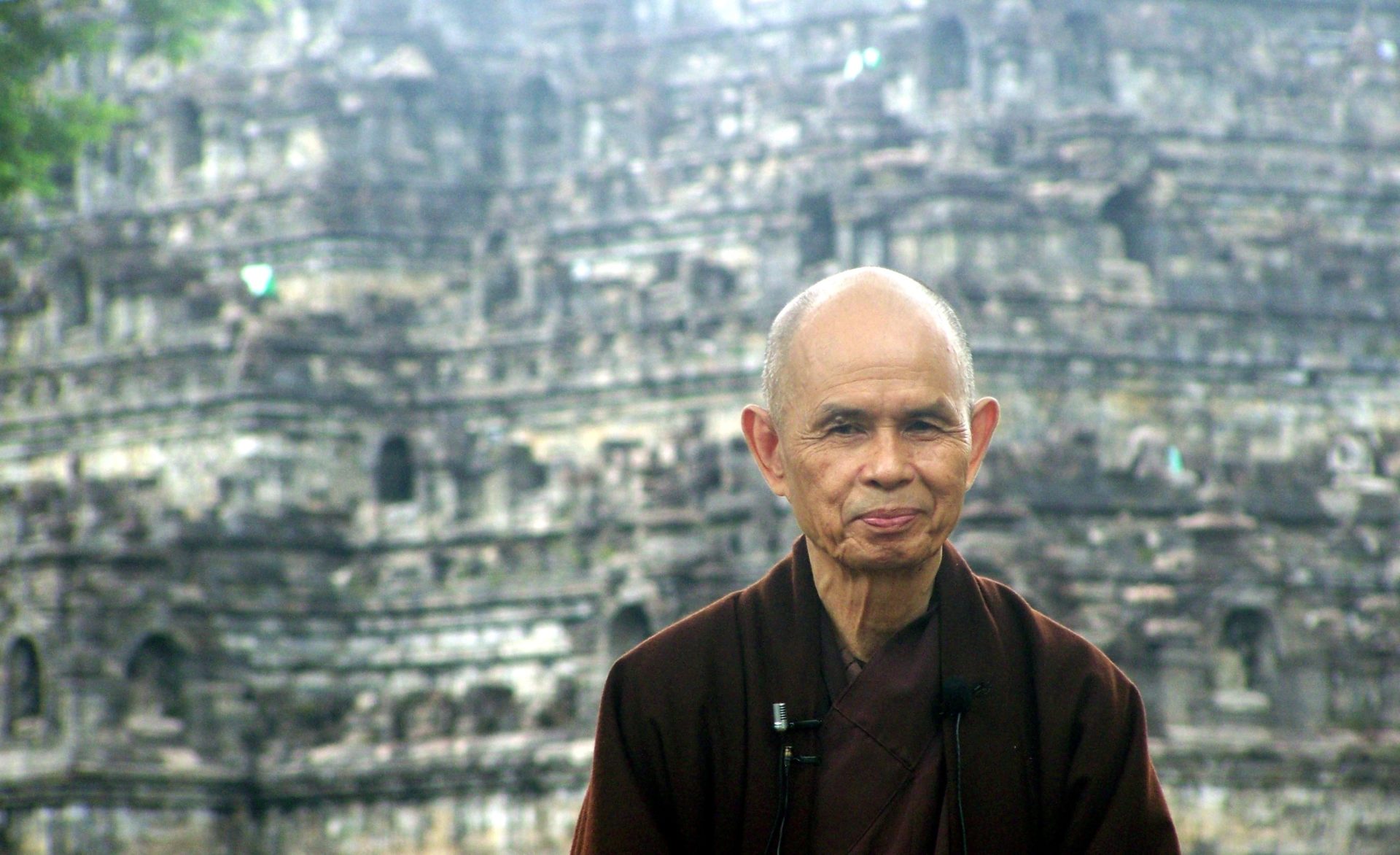By Jim Forest on
Jim Forest shares stories of working with and learning from Thích Nhất Hạnh in the late 1960s
One action
I first met Thich Nhat Hanh in May 1966. At the time Lyndon Johnson was America’s president. The steadily rising level of U.S. troops in Vietnam reached 384,300 that year and within the next eighteen months would expand to half a million.
By Jim Forest on
Jim Forest shares stories of working with and learning from Thích Nhất Hạnh in the late 1960s
One action
I first met Thich Nhat Hanh in May 1966. At the time Lyndon Johnson was America’s president. The steadily rising level of U.S. troops in Vietnam reached 384,300 that year and within the next eighteen months would expand to half a million. But support for the war was shrinking. The nation had become deeply divided—never before had so many Americans opposed a war being fought by their own government. There were huge protest demonstrations in many cities. Conscientious objection was on the rise; thousands were refusing to serve in the military. Young men were burning their draft cards or crossing the border to Canada. A significant part of the war’s opposition was religious. In America the ranks of protesters included many prominent Christians and Jews, while in Vietnam tens of thousands of Buddhists, many of them monks whose monasteries had been scarred by war, were engaged in antiwar activities. Display of the Buddhist flag had been banned. In 1963, one leading Buddhist monk, Thich Quang Duc, had stunned the world when he burned himself alive in response to anti-Buddhist repression by the U.S.-backed Saigon government. In July 1965, Al Hassler, executive secretary of the Fellowship of Reconciliation, had led a fact-finding mission to Vietnam that included meetings in Saigon with Buddhist leaders who had organized demonstrations that had been brutally attacked by South Vietnamese police. The monk who most impressed Hassler was the Zen Master Thich Nhat Hanh. A friendship quickly took root between them that was to influence the rest of both men’s lives. Hassler wanted Nhat Hanh’s voice to be heard in America.
How dare I imagine there were chemical shortcuts to enlightenment!
When I met Thich Nhat Hanh at the Fellowship of Reconciliation headquarters in Nyack, New York, he was thirty-nine and I was twenty-four. I had just been appointed director of the Fellowship’s Vietnam program while also serving as co-secretary of the Catholic Peace Fellowship. In introducing him to the FOR staff, Al Hassler explained that Nhat Hanh was the leading figure in the development of “engaged Buddhism,” a movement of religious renewal that linked insights gained from Buddhist teaching to hands-on engagement in situations of suffering. He was a founder of Van Hanh University in Saigon and had played a leading role in efforts to bring the several strands of Vietnamese Buddhism into greater harmony, resulting in the creation of the Unified Buddhist Church. He was also the initiator of the School of Youth for Social Service, which prepared hundreds of young Vietnamese volunteers to serve in war-torn rural communities. In Vietnam he was a widely read author, though almost unknown outside his homeland. None of his twelve volumes of poetry or other writings had yet been published in English or other Western languages. This was not Nhat Hanh’s first visit to the United States, Hassler added. For nearly three years he had studied comparative religion at Princeton and lectured on Buddhism at Columbia University. His current U.S. visit had been made possible by an invitation to speak at Cornell University.

Seeking enlightenment and saying no
Al Hassler was the staff person who most often accompanied Nhat Hanh wherever he went in America, but occasionally another Fellowship of Reconciliation staff member might have that privilege. One evening I was pressed into the job. Nhat Hanh was waiting for me at an apartment where he was staying near Columbia University. We went by subway to a small gathering at a posh apartment on Park Avenue in midtown Manhattan. The event we attended turned out to be disappointing. Slipping away at the earliest possible moment, we returned to the street. I suggested perhaps a cup of tea wouldn’t be a bad idea. Nhat Hanh agreed. We found a neon-lit Chinese café, and there it was that I decided to ask a question that I thought only a Zen master could answer. Not many weeks before, while at the University of Oklahoma to give a lecture on Vietnam, I had tried the hallucinogenic drug LSD at the invitation of a member of the chemistry faculty. It was an experiment way off my beaten track, but Aldous Huxley’s book The Doors of Perception had stirred an interest in consciousness-expanding drugs. At the time LSD was not illegal. It had been described by my chemist friend as triggering “a profound spiritual experience, even a chemical shortcut to enlightenment.” That night-long inner pilgrimage had, in the vocabulary of the sixties, blown my mind. For perhaps ten or twelve hours—in fact I found myself outside of time—I dived into my subconscious brain in which eternity was a reality rather than a concept. I was able to watch a fragment of sound drift slowly into my head and observe how my neurons received that sound and eventually made decisions about it, deciding it was, for example, a syllable of a word or a note of music, a sound to be welcomed or a danger-related noise that required my moving away. Just to hear and decode a simple sentence was a major event experienced in hyperslow motion. The traffic-directing, sorting-out, editing-room part of the brain was, I found, a bright, colorful, contemplative metropolis methodically making sense of the avalanche of data constantly being provided by my senses, at the same time comparing this with that, taking a fresh look at potentially relevant memories, making wild guesses, considering what response if any might be required to what was going on around me. Slowly emerging from the experience at dawn, I felt I had lived, or was still living, an infinity of lifetimes. It was also an experience of constant awe—of being in the divine presence. Afterward I wondered if indeed this might be enlightenment. Now I was face to face with one of the few people who would know, but to ask seemed risky. Might a Zen master be scandalized by such a question? How dare I imagine there were chemical shortcuts to enlightenment! What impertinence! But what the hell, I decided—I’ll never have another chance to know. And so I asked.
Nhat Hanh’s eyes widened in surprise. There was no trace of irritation, only curiosity. Looking back, I think he was astonished that there were people involved in antiwar protest who were interested in enlightenment. “Please tell me what you experienced,” he said. I did my best to do so and have rarely been listened to so attentively. When I finished, Nhat Hanh said, “Perhaps it is not enlightenment—no chemicals can do that—but you are on the way.” He added that he had once tried marijuana but would never do so again—he had not been able to sleep for days afterward. There was a deep sense of connection, an almost audible click. Then he asked if in the future I would accompany him on his FOR-arranged travels whenever Al Hassler was unavailable. “If you say yes, you have to be good at saying no,” he added. “Every third day for me is a day of mindfulness. On those days under no circumstances will I give any talk or participate in any meeting, no matter how important it may seem. On those days I need someone who can be a stone wall. Can you do that? Others have said they could but in actual practice could not. For them the proposed event was too important. Also I want no more than two events per day on the days between.” “I am good at saying no,” I assured him. “I can say no to the president or to the pope. I like the word no.” After that evening we traveled together a great deal, East Coast to West and back. I had many opportunities to say no to interview requests, meetings with important people, opportunities that, on any other day, would have been worthwhile. My no was waterproof.
“You have to learn how to breathe while you walk,” he replied. “Let’s go back to the bottom and walk up again. I will show you how to breathe while climbing stairs.”
Climbing stairs and mindful breathing
It was from Nhat Hanh that I first became aware that walking and attention to breathing both provide opportunities to repair the damaged connection between the physical and spiritual. In conversation Nhat Hanh sometimes had spoken of the importance of what he called “mindful breathing,” a phrase that seemed quite odd to me at first. Yet I was aware that his walking was somehow different than mine and could imagine this might have something to do with his way of breathing and also his way of listening. Even if we were late for an appointment, he always walked in an attentive, unhurried way. “Better to be late,” Nhat Hanh said, “than breathless. What is most important is to be in the present moment.” It wasn’t until we climbed the steps to my sixth-floor apartment in East Harlem that I began to understand. Though quite fit, I was always out of breath by the time I reached my front door. Nhat Hanh, on the other hand, seemed rested. I asked him how he did that. “You have to learn how to breathe while you walk,” he replied. “Let’s go back to the bottom and walk up again. I will show you how to breathe while climbing stairs.” While I was not thrilled to repeat the climb, on the way back up, Nhat Hanh quietly described how he was breathing—a breath in for one step, a breath out for the next, a brief rest on the landings. It wasn’t a difficult lesson. Linking slow, attentive breaths with climbing the stairs made an astonishing difference. The climb took a little longer, but when I reached my door I found myself refreshed instead of depleted.
Ginger tea and fragrant palm leaves
On the road, Nhat Hanh was always awake before I was. His nights were short. When he decided it was time to wake me, he would sit at the foot of whatever bed or couch I was using and quietly say, “Wake up, Jim! Wake up! Don’t you want some ginger tea?” There was a pot of tea in his hand, the perfume smell of fresh-cut ginger in the air, a happy smile on his face and a teasing look in his eyes.
While drinking cups of fresh tea each morning, Nhat Hanh was often reminded of Phuong Boi Monastery, a mountain retreat two hundred kilometers from Saigon, which he and several friends had founded in 1957. “Phuong boi means fragrant palm leaves,” he explained. “We were a small experimental community in the Central Highlands supporting ourselves by growing tea. We had no rule and there was no dress code—I dressed as I pleased and would go for days without shaving. I was a hobo monk! Each day created its own rule. We tended the tea plants as needed, but for the rest of each day we could study or write or go for a hike or arrange a picnic or rest in a hammock. To be at Phuong Boi was to visit the Pure Land described in Buddhist sutras. We were far from civilization. From footprints they left in the soft earth, we could see that we shared our Pure Land with several tigers, but they must have been Buddhist tigers—we sometimes encountered them but they caused us no harm. There were also tribal people, the Montagnards, living not far away, who sometimes visited us. We drank tea together. But our experiment lasted only three years. Phuong Boi was closed in 1960 when agents of the government arrested one member of the community and forced the rest of us to leave. I returned to Saigon. It was a very sad day but the memories are sweet.” I asked what had led him away from urban life and the many existing monasteries to seek refuge in the mountains. “Each of us had been made to feel unwelcome by the Buddhist hierarchy as it was at that time. The accusation was that I was sowing dissent. I had been editing a magazine, Voice of the Rising Tide, that called for the development of a renewed Buddhism more responsive to the needs of the people, but the magazine was closed and our ideas rejected. I realized taking some distance and being quiet would be a wise step.”
Chopsticks
Almost every evening there was an invitation for us to have a meal with a family that had played a part in arranging whatever Nhat Hanh was doing locally, but with rare exceptions the response I had to make was, “No thank you—Thich Nhat Hanh is too tired.” Table conversation, he had explained to me, was too tiring. We would be brought to wherever we were staying, say goodnight, and then look for a Chinese restaurant, the simpler and plainer the better. Our meals were often playful. Nhat Hanh banned the use of knives, forks, and spoons. He wanted me to become at home with chopsticks. Little by little I made headway. He enjoyed making me practice lifting melting ice cubes out of glasses of water. Much laughter.
A clock in place of a crucifix
Thay noticed things that I hardly noticed and took absolutely for granted, as happened one day at the University of Michigan. He had been invited to give a lecture on the war in Vietnam, to be followed by a poetry reading. Waiting for the elevator doors to open, I noticed Thay gazing at the clock above the doors. Then he said, “You know, Jim, a few hundred years ago it would not have been a clock, it would have been a crucifix.” So simple but so startling a comment. He was right. More than a tool of social coordination, the clock has become a quasi-religious object in our world, a symbol of unity, a collective conveyer belt, a symbol so powerful that it could depose the crucifix.
Saying yes
It isn’t easy to describe the influence Thay had on me in the course of our travels. Partly it was simply guidance about what I would call being in a state of prayer, and Thay would call it mindfulness or being in the present moment. In contrast with Dan and Phil Berrigan, good friends with whom I was also working closely, Thay exerted no pressure on me to do more than I was already doing to end the war in Vietnam. But because of Thay, Vietnam was no longer a distant country. It was as close as Thay’s voice. Its tragedies were mine. I had broken into what Thomas Merton called “the human dimension.” When I was invited to be part of a community that was preparing to impede military conscription by burning draft records, with the probability of a long period in prison as a consequence, part of the reason I said yes was my love of Thich Nhat Hanh and the awareness that Vietnam—though I had never been there except through Thay—was part of my home.
This is an excerpt from Eyes of Compassion: Learning from Thich Nhat Hanh by Jim Forest, reprinted courtesy of Orbis Books, available at orbisbooks.com and parallax.org.


